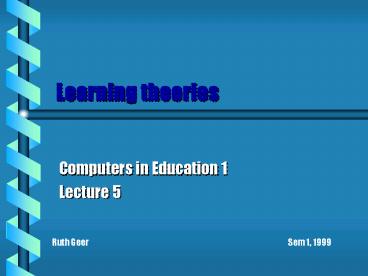Learning theories - PowerPoint PPT Presentation
1 / 16
Title:
Learning theories
Description:
Most students today will experience at least 4 career changes in their lifetime ... Organising. Elaborating. Imagery. Ruth Geer. Sem 1 1999. Slide 6 ... – PowerPoint PPT presentation
Number of Views:94
Avg rating:3.0/5.0
Title: Learning theories
1
Learning theories
- Computers in Education 1
- Lecture 5
Ruth Geer
Sem 1, 1999
2
Changes brought about by technology
- Most students today will experience at least 4
career changes in their lifetime - The base of essential knowledge is growing
constantly - Knowing what questions to ask will be as
important as the right answers - Emphasis on becoming skilled decision- makers
3
Views on learning
- Disagreement over what strategies are most
effective to achieving todays goals - two views clearly identifiable
- directed instruction (grounded in behaviourist
theory information processing branch) - constructivist (other branches of cognitive
learning theory)
4
Theories associated with directed instruction
- Behavioral theories
- Skinner, Thorndike, Gagne
- - observable indications of learning
- - sequence of stimulus - response actions
- Information processing theories
- Atkinson, Ausubel, Gagne ( guided development
of Artificial Intelligence) - - model of memory
- - receive and store information
5
Information Processing theories
Lost
Lost
Lost
Input
Working (Short-term) Memory
Long- term Register
Sensory Register
Attention
Rehearsal Meaningful Learning Organising Elaborati
ng Imagery
6
Characteristics of directed instruction
- Associated with teacher-directed , more
traditional instruction and assessment methods - Clearly stated skills objectives
- Test items matching objectives
- More individualised work than group work
7
Needs addressed by directed instruction
- Individual pacing and remediation
- Providing self instructional sequences
- Performing time consuming and labour intensive
tasks - More efficient learning
8
Instructional aims and objectives - Systems
approach
- Am I teaching what I intended to teach?
- Do my students have lower level skills?
- Do the tests measure what I teach?
- Are my instructional activities appropriate?
- How successful have students been in meeting the
objectives?
9
Gagnes events of instruction
- Guidelines for optimal conditions of learning
- gaining attention
- informing learner of objective
- stimulating recall
- presenting new material
- providing learning guidance
- eliciting performance
- providing feedback
- assessing performance
- enhancing retention and recall
10
Theoretical foundations of constructivism
- Derived from branches of cognitive science
- Dewey - centre instruction around meaningful
activities - Vygotsky - scaffolding, zone of proximal
development - Piaget - learners are active and motivated,
interaction with environment - Bruner - stages of intellectual development
- Papert - learners build own intellectual structure
11
Characteristics of constructivist learning
- Problem-oriented learning
- Learning through exploration
- Emphasis on cooperative learning
- Rich environments
- Authentic assessment methods
- Emphasis on more global goals
12
Needs addressed by constructivist learning model
- Skills are made more relevant
- Enhanced motivation through active engagement
- Cooperative learning
- Higher order skill development
13
Integration based on directed instruction model
- Remedy identified weakness
- Promote automaticity of prerequisite skills
- Make learning more efficient
- Remove logistical hurdles
14
Integration based on constructivist model
- Encourage motivation to learn
- Foster creativity
- Increase transfer of learning
- Foster collaborative learning
- Facilitate self-analysis and metacognition
15
Characteristics of constructivist approach
- Learning through exploration and discovery
- Emphasis on group work
- Learning focused around more authentic tasks
16
Merging of approaches
- Molenda (1991) - students should be able to move
from one approach to the other depending on
learning needs - Bereiter (1990) - argues for a more all-inclusive
learning theory - different methods required for different types of
problems - Roblyer, Edwards, Havriluk (1997) - neither model
in itself meets needs of all students































